by
Guru Brar
Robert Gorter, MD, PhD, emeritus professor of the University of California San Francisco Medical School (UCSF)
On request of the speaker of the parliament of Lebanon his Excellency Dr. Nabih Berri, Robert Gorter visited Lebanon for the sixth time from August 21st through 25th, 2018.
His first visit to Lebanon was in 2003 when he met the President at that time, Emile Lahoud, at his presidential palace.

President Emile Lahoud (l) with Dr. Robert Gorter at his palace in Beirut, discussing the possibilities to grow Cannabis for both medical and industrial purposes in the Bekaa

Prof. Robert Gorter (l), Prime Minister Fouad Siniora (m), and Dr. Tony Licha’a (r) at the office of the Prime Minister in Beirut (2005)
The PM at that time, Mr. Fouad Siniora, was very supportive of the idea to create thousands of jobs and re-enliven the cultivation of industrial hemp and possibly the production of various cannabinoids in the Bekaa.

Dr. Robert Gorter (l) with the Prime Minister Tammam Salam discussing Gorter’s latest book on non-toxic cancer treatment, the “Gorter Model,” where Cannabis plays an important role (2013/2014)

Prof. Dr. Robert Gorter (l) and His Excellency Dr. Nabih Berri (August23rd, 2018)
Under the professional leadership of Mr. Ali Hamdan (Senior Advisor to Mr. Nabih Berri), the meeting with Dr. Nabih Berri took place on August 23rd 2018 and it had been prepared during the three days preceding the meeting.
https://www.lbcgroup.tv/news/news-bulletin-reports/397840/Lebanon-news-lbci/en

Leading newspapers (like the Al Diyar of August 24th, 2018) and national and international news broadcasting TV channels paid attention to the visit of Dr. Gorter and the purposes of the visit
Section 1: Fiber (Industrial) Hemp
Industrial hemp contains less than 0.2% THC. In coffee shops, owned by the local city governments of Amsterdam and almost any city in the Netherlands, Hemp seeds can be obtained legally which will grow Hemp which contains up to 14% THC. Hemp seeds themselves do not contain any THC.
Hemp or industrial hemp (from old English hænep), typically found in the northern hemisphere, is a variety of the Cannabis sativa plant species that is grown specifically for the industrial uses of its derived products. It is one of the fastest growing plants and was one of the first plants to be spun into usable fiber 7,000 years ago. It can be refined into a variety of commercial items including paper, textiles, clothing, biodegradable plastics, paint, insulation, biofuel, food, animal feed and human nutrition. In addition, cannabinoids like CBD can be extracted from industrial hemp.
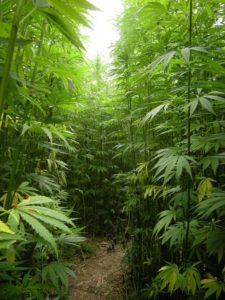
Fiber Hemp fields in Côtes-d’Armor, Brittany, France, and Hemp seeds
Although recreational marijuana and industrial hemp are both members of the species Cannabis sativa and may contain the psychoactive component delta-9-tetrahydrocannabinol (THC), they are distinct strains with unique biochemical compositions and uses. Hemp has lower concentrations of THC and higher concentrations of Cannabidiol (CBD), which decreases or eliminates its psychoactive effects. The legality of industrial hemp varies widely between countries. International law regulates the concentration of THC and permit hemp that’s bred with a low THC content: usually <0.2%.
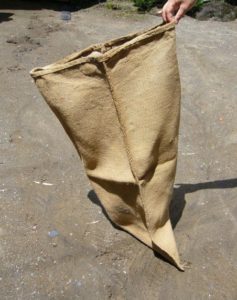
Hemp stem showing fibers and one of many end products: a sack for storage
Hemp seeds
Hemp is used to make a variety of commercial and industrial products including rope, clothes, food, paper, textiles, plastics, insulation and biofuel. The bast fibers can be used to make textiles that are 100% hemp, but they are commonly blended with other organic fibers such as flax, cotton or silk, to make woven fabrics for apparel and furnishings. The inner two fibers of the plant are woodier and typically have industrial applications, such as mulch, animal bedding and litter. When oxidized (commonly referred to as “drying”), hemp oil from the seeds becomes solid and can be used in the manufacture of oil-based paints, in creams as a moisturizing agent, for cooking, and in plastics. Hemp seeds have been used in bird feed mix as well. A survey in 2003 showed that more than 95% of hemp seed sold in the European Union was used in animal and bird feed.
Hemp seeds can be eaten raw, roasted, ground into a meal, sprouted, or made into dried sprout powder. The leaves of the hemp plant can be consumed raw in salads. Hemp can also be made into a liquid and used for baking or for beverages such as hemp milk, hemp juice, in beer and chocolate to give it its typical bitter taste and tea.
Hempseed oil is cold-pressed from the seed and is high in unsaturated fatty acids. In 2017, the U.S. imported approximately $600 million worth of hemp products, mostly driven by growth in demand for hemp seed and hemp oil for use as ingredients in foods such as granola.
In 2018, China is expected to by-pass France as the largest hemp exporter in the world.
Currently, there is a fast-growing market for hemp pulp, for example as high-quality paper. Hemp fiber is extremely durable and cannot rot. The pharaohs of ancient Egypt were all wrapped up and held together by hemp fibers and cloth made of hemp (canvas from Cannabis).
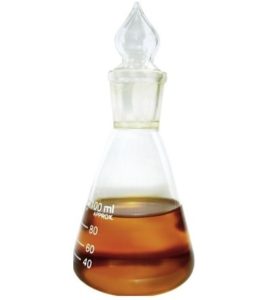
Hempoline (biodiesel)
Biodiesel are made from the oils in hemp seeds and stalks and alcohol fuel (ethanol or, less commonly, methanol) from the fermentation of the whole plant. Biodiesel produced from hemp is sometimes known as “hempoline.”
The world-leading producer of hemp is China, which produces more than 55% of the world output in 2017. There is smaller production in Europe, Chile and North Korea. Over thirty countries produce industrial hemp, including Australia, Austria, Canada, Chile, China, Denmark, Egypt, Finland, Germany, Great Britain, Hungary, India, Italy, Japan, Korea, The Netherlands, New Zealand, Poland, Portugal, Romania, Russia, Slovenia, Spain, Sweden, Switzerland, Thailand, Turkey and Ukraine. As part of a campaign to stimulate sustainable agriculture, the European Union (EU) supports farmers who want to switch to the cultivation of fiber Hemp with 5.000€ per hectare.
Graphene
Graphene is an allotrope of carbon in the form of a two-dimensional, atomic-scale, honey-comb lattice in which one atom forming a vertex. It is the basic structural element of other allotropes, including graphite, charcoal, carbon nanotubes and fullerenes. It can also be considered as an indefinitely large aromatic molecule, the ultimate case of the family of flat polycyclic aromatic hydrocarbons.
Graphene has many extraordinary properties. It is about 100 times stronger than the strongest steel. It conducts heat and electricity efficiently and is nearly transparent. Graphene also shows a large and non-linear diamagnetism, even greater than graphite, and can be levitated by Nd-Fe-B magnets. Researchers have identified the bipolar transistor effect, ballistic transport of charges and large quantum oscillations in the material.
Scores of scientists have theorized about the properties of graphene for decades. It has likely been unknowingly produced in minute quantities for centuries, through the use of pencils and other similar applications of graphite. It was originally observed in electron microscopes in 1962, but only studied while supported on metal surfaces. The material was later rediscovered, isolated and characterized in 2004 by Andre Geim and Konstantin Novoselov at the University of Manchester. Research was informed by existing theoretical descriptions of its composition, structure and properties. High-quality graphene proved to be surprisingly easy to isolate, making more research possible. This work resulted in the two winning the Nobel Prize in Physics in 2010 “for groundbreaking experiments regarding the two-dimensional material graphene.”
The global market for graphene is reported to have reached $9 million by 2012 and 300€ in 2015 and 700 € in 2017 with most sales in the semiconductor, electronics, battery energy, telecommunications, super conductors and composites industries.
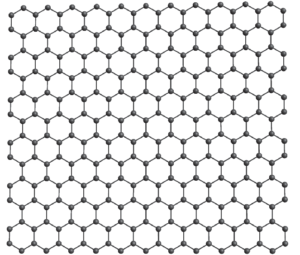
Graphene is an atomic-scale honeycomb lattice made of a single layer of carbon atoms and is related to diamond, the hardest substance on earth and consists of carbon atoms only
Conventional batteries store large reservoirs of energy and drip-feed it slowly, whereas supercapacitors can rapidly discharge their entire load.
They are ideal in machines that rely on sharp bursts of power. In electric cars, for example, supercapacitors are used for regenerative braking.
Releasing this torrent requires electrodes with high surface area – one of graphene’s many phenomenal properties.
Market Demand
Hemp fiber produced in the EU has gone to a variety of uses. However, most of the market information is rather anecdotal and suggests a niche market of limited scale. Examples of hemp markets in various Member States follow:
Hemcore, one of the largest hemp companies in England, currently contracts about 12,000 acres of hemp for hurd production (the woody inner core of the stalk) for use as horse bedding. Hemcore has also developed a new spinning technology. Another UK company, Friendship Estates, sells hemp bedding for the pet industry. The Bioregional Development Group in Surrey has developed flax and hemp fibers for textiles and paper production. The hurds and seeds could also be used for composite board, linoleum, and animal feed.
Hemp cultivation areas in Europe have expanded from 8,000 ha in 2011 to almost 25.000 ha in 2016 and 30.000 ha in 2017, which shows a triple increase in 5 years. The reason is the growing demand for different raw materials obtained from this outstanding multi-purpose crop. Hemp fibers are used in the automotive industry as well as in insulation and specialty paper production. They are particularly well established as material for natural fiber composites (NFC) used for the reinforcement of automotive interior parts. Due to their huge potential in light-weight construction, the demand for NFC has been growing continuously. Whereas exotic natural fibers from Asia are suffering from limited availability because of the local competition with food crops and temporary export bans, European hemp fibers can meet increasing demands – if the demand is communicated before the sowing time in March. Hemp seeds are becoming an important factor in both functional and supplement food industries. In 2015, hemp food products entered the mainstream market and were produced by well-known companies. Farmers in more and more European countries are discovering hemp as an alternative crop for the production of hulled hemp seeds, protein powder and oil with high nutritional value. Hemp seed is a nutritional powerhouse and is highly digestible. Its oil has an excellent fatty acid spectrum, it has the “almost perfect” balance of the omega-3 and -6 essential fatty acids plus the presence of two “higher” omega-3 and -6 fatty acids, stearidonic acid (SDA) and gamma linoleic acid (GLA), the share of unsaturated fatty acids is incredible 90%. The protein includes all 21 amino acids providing minerals, Vitamin E and is high in dietary fiber. In addition, the hemp crop produces Cannabidiol (CBD), a food supplement with therapeutic potential, which does not have any psychoactive effects. Many companies are globally investing in hemp as natural drug; this new natural medicine could reach at least a similar significance as valerian. The German company and EIHA member “Hanf Farm GmbH” is the first hemp producer worldwide to receive the “International Sustainability and Carbon Certification (ISCC PLUS)” for their hemp raw material “Hemp flower” and “Hemp nuts”. More certifications for different hemp products will follow this year, including those for the fiber. The European Industrial Hemp Association (www.eiha.org) is the organization of the European Hemp Industry. It represents cultivators, processors, producers and traders as well as scientists.”
European Industrial Hemp Association (EIHA) is a consortium of the hemp-processing industry. It represents the common interest of industrial hemp farmers and producers, both nationally and on a European level. EIHA is the only European consortium in the industrial hemp sector. This sector includes, amongst other things, the use of hemp fibers, shavings, seeds and cannabinoids. Although originally founded as an association for the European hemp industry, a quarter of the 130 EIHA’s members are based in countries outside the EU.
Industrial hemp is making its “Coming Back” in the EU, the USA and Canada. Hemp’s many uses from food to paper to cloth and clothing to modern technologies such as hempcrete are just astounding. The most ground breaking of these though is hemp “graphene.”
To explain, regular graphene is comprised of a two-dimensional, hexagonal honeycomb lattice layer of tightly packed carbon atoms, and is one of the strongest, lightest and most conductive compounds ever discovered. It is considered one of the best materials for supercapacitor electrodes. The term was also used in early descriptions of carbon nanotubes, and can be considered a type of nanotechnology. Many of graphene’s uses are in the area of energy storage; some uses that are under development include electronics, biological engineering, filtration and strong, lightweight composite materials.
However, a scientist by the name of Dr. David Mitlin from Clarkson University in New York says he’s found a way to manufacture hemp waste into a material that appears to be better than graphene. Dr. Mitlin and his team were able to recycle leftover hemp-based fiber, cook it down and then dissolve it until carbon nano sheets that resembled the structure of graphene were left behind. They proceeded to build these nano sheets into powerful energy-storing supercapacitors with high energy density, thus creating a hemp-based “graphene.” Essentially, Mitlin’s team discovered a process for converting fibrous hemp waste into a unique graphene-like nanomaterial that many say out-performs graphene.
Creating this graphene-like hemp material costs only a fraction of regular graphene production. Graphene costs as much as 2,000€ per gram to manufacture, while the hemp-based nanomaterial can be manufactured for less than approx. 500€ per ton. To give proper perspective; there are 1.000.000 grams in one ton.
Hemp professionals and activists in Oregon and elsewhere in the USA and the EU are thrilled about this new technology and its potential for energy. Ben Christensen, owner of Oregon Hemp Works in Portland, said, “As a renewable energy major and hemp business owner, I find this very exciting. One of the bigger challenges with renewable energy is storage. I often find hemp being left out of the renewable energy conversation, but I feel you can’t really talk about renewable energy or sustainability unless hemp is being talked about as well. It also seems that when hemp is introduced as a replacement, it is just as good as what it’s replacing and even better in a lot of cases.”
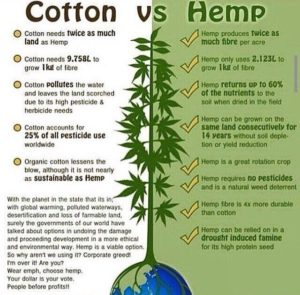
Industrial hemp can replace cotton in many areas of human consumption.
Most people don’t understand the truly diverse value of hemp. Cultures have relied on this hardy plant for centuries to produce textiles such as clothing, fabric and paper. Columbus could never have discovered the Americas without the canvas of his sailing ships; the oil to make the ship water proof; the seeds to nurture his crew and the paper for his log book. Today, hemp is also used for food, fuel, medicine, building materials, batteries, superconductors and plastics. Now, with the energy storage industry starting to take notice, perhaps more government authorities will take a closer look at this plant.
Car Industry
Hemp plastic is 40% lighter than aluminum and about 4 times as strong. Therefore, Hemp plastic will replace aluminum more and more in the near future.

Henry Ford (Chicago) axing his car made of hemp plastic (1941)

Henry Ford next to his newly developed car made from hemp plastic and the engine running on hemp oil diesel (1941/1942)

BMW has come out with an all-electric, hemp fiber car, which made its world debut in 2017. And in true BMW fashion, they’ve outdone just about every other electric car in what matters most: Weight. The BMW i3 is a mere 1.225kg (365kg less than the Nissan Leaf and the Chevy Volt)
 Hemp materials (Hemp plastics) contribute to the BMW i3′s natural looking interior
Hemp materials (Hemp plastics) contribute to the BMW i3′s natural looking interior
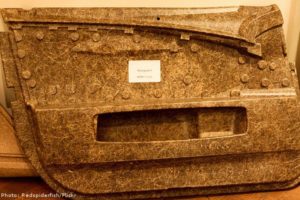
A BMW 5 series door panel completely made out of hemp

The i8 will be the next electric car sold by BMW. The hybrid supercar accelerates from 0 to 100 km/h in 4.8 seconds and has an electronically limited top speed of 250 km/h. All thanks to the latest Hemp fiber technology including its chassis and batteries made from graphene

Prince Harry, Duke of Sussex, and Meghan Markle, Duchess of Sussex, leave Windsor Castle in Windsor on May 19, 2018 in an E-Type Jaguar after their wedding to attend an evening reception at Frogmore House. Source GettyImages/Noam Galai
There are no pricing details yet because each car is uniquely made and assembled from a previous model with major parts made from fiber hemp. Jaguar Land Rover anticipates deliveries of the first electric E-type vehicles to start in the summer of 2020.
Dr. Gorter:
“The car industry came first; the aviation industry will follow. I predict that in 20 years, commercial airplanes made from hemp plastic with their turbines running on Hemp diesel (kerosene) will fly routinely around the world.”
Section 2: Medicinal Hemp or Marijuana (Cannabis sativa)
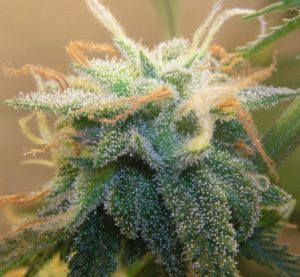
The bud of a Cannabis sativa flower coated with trichomes which can bear many cannabinoids, including Cannabidiol (CBD), Tetrahydrocannabinol (THC)
Medicinal Hemp has been defined as Hemp containing >0.2% THC. Usually, Medicinal Hemp is cultivated for its THC content which is the only Cannabinoid out of 111 isolated and well-defined Cannabinoids as of today which has psychotropic effects.
Table 1. Pharmacologic Characteristics of Some Main Cannabinoids
| Effect | Delta-9-THC | CBD | CBG | CBN | Delta-8-THC |
| Vomiting | ¯ | ||||
| Appetite | | ||||
| Spasticity | ¯ | ¯ | |||
| Epilepsy | ¯ | ¯ | ¯ | ¯ | |
| Migraine | ¯ | ||||
| Pain | ¯ | ¯ | ¯ | ||
| Eye Ball Pressure | ¯ | ¯ | ¯ | ¯ | ¯ |
| Bronchial Dilatation | | ® | ® | ||
| Bacterial Growth | ¯ | ¯ | ¯ | ||
| Inflammation | ¯ | ¯ | |||
| Relaxation | | | | | |
| Urinary Excretion | | ||||
| Gut Motility | ¯ | ® | ¯ | ||
| Core Temperature | ¯ | | |||
| Coronary Flow | (¯) | | ® | ||
| Pulse | | ® | ¯ | ||
| Skin Sensitivity | | ||||
| Psychotropic Effects | | ¯ | () | ||
| Survival various Cancers | | |
|
||
| Anti-Aging | | | |||
| Reverse and prevent dementia | | | |||
| Increasing learning capabilities | | | |||
| Duchenne Muscle Dystrophy (DMD) | | | |||
| Preventing & treating Diabetes mellitus type 2 | | | |||
| Opiate detox | | | |||
| Treating insomnia | | |
Table 1 by Robert Gorter
For extensive information on CBD and THC see the “Expert Report” by Dr. Robert Gorter as an appendix to this report.
www.bbc.com/news/science-environment-28770876
www.nova-institut.de/bio/index.php?tpl=novalist
https://www.youtube.com/watch?v=srgE6Tzi3Lg